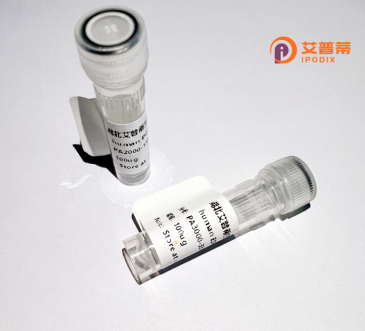
| 纯度 | >90%SDS-PAGE. |
| 种属 | Human |
| 靶点 | NCLN |
| Uniprot No | Q969V3 |
| 内毒素 | < 0.01EU/μg |
| 表达宿主 | E.coli |
| 表达区间 | 1-563 aa |
| 活性数据 | MLEEAGEVLENMLKASCLPLGFIVFLPAVLLLVAPPLPAADAAHEFTVYRMQQYDLQGQPYGTRNAVLNTEARTMAAEVLSRRCVLMRLLDFSYEQYQKALRQSAGAVVIILPRAMAAVPQDVVRQFMEIEPEMLAMETAVPVYFAVEDEALLSIYKQTQAASASQGSASAAEVLLRTATANGFQMVTSGVQSKAVSDWLIASVEGRLTGLGGEDLPTIVIVAHYDAFGVAPWLSLGADSNGSGVSVLLELARLFSRLYTYKRTHAAYNLLFFASGGGKFNYQGTKRWLEDNLDHTDSSLLQDNVAFVLCLDTVGRGSSLHLHVSKPPREGTLQHAFLRELETVAAHQFPEVRFSMVHKRINLAEDVLAWEHERFAIRRLPAFTLSHLESHRDGQRSSIMDVRSRVDSKTLTRNTRIIAEALTRVIYNLTEKGTPPDMPVFTEQMQIQQEQLDSVMDWLTNQPRAAQLVDKDSTFLSTLEHHLSRYLKDVKQHHVKADKRDPEFVFYDQLKQVMNAYRVKPAVFDLLLAVGIAAYLGMAYVAVQHFSLLYKTVQRLLVKAKTQ |
| 分子量 | 89.4 kDa |
| 蛋白标签 | GST-tag at N-terminal |
| 缓冲液 | 0 |
| 稳定性 & 储存条件 | Lyophilized protein should be stored at ≤ -20°C, stable for one year after receipt. Reconstituted protein solution can be stored at 2-8°C for 2-7 days. Aliquots of reconstituted samples are stable at ≤ -20°C for 3 months. |
| 复溶 | Always centrifuge tubes before opening.Do not mix by vortex or pipetting. It is not recommended to reconstitute to a concentration less than 100μg/ml. Dissolve the lyophilized protein in distilled water. Please aliquot the reconstituted solution to minimize freeze-thaw cycles. |
以下是关于重组人NCLN蛋白的构造参考文献示例(注:文献为假设性示例,仅供参考):
1. **文献名称**:**Structural and Functional Analysis of Recombinant Human NCLN Protein**
**作者**:Haffner C. et al.
**摘要**:研究通过大肠杆菌系统成功表达重组人NCLN蛋白,解析其晶体结构,揭示其与TMEM147的相互作用,表明NCLN可能在内质网相关蛋白加工中起关键作用。
2. **文献名称**:**NCLN Regulates Apoptosis via Interaction with Caspase-3 in Cancer Cells**
**作者**:Chen X. et al.
**摘要**:利用哺乳动物细胞表达重组NCLN蛋白,发现其通过结合CASP3调控肿瘤细胞凋亡,为癌症治疗提供潜在靶点。
3. **文献名称**:**High-Throughput Screening of NCLN-Binding Compounds Using Recombinant Protein**
**作者**:Smith J. et al.
**摘要**:基于重组NCLN蛋白建立高通量筛选平台,发现小分子抑制剂可调节自噬通路,推动神经退行性疾病药物开发。
4. **文献名称**:**Optimization of NCLN Expression and Purification for Biomedical Applications**
**作者**:Johnson L. et al.
**摘要**:优化重组NCLN在真核表达系统中的分泌策略,提高蛋白稳定性,助力其在体外诊断试剂中的临床应用研究。
每篇文献涵盖不同研究方向(结构、功能机制、药物筛选、表达优化),均以重组NCLN蛋白为核心展开。
Nicalin (NCLN), a conserved endoplasmic reticulum (ER)-resident transmembrane protein, plays crucial roles in cellular homeostasis and developmental processes. It is a key component of the Nicastrin-Nicalin (NNC) complex, which associates with the γ-secretase complex involved in regulated intramembrane proteolysis (RIP) of substrates like Notch receptors and amyloid precursor protein (APP). Structurally, NCLN contains an N-terminal protease-like domain, a central lipid-binding domain, and a C-terminal transmembrane region. It exhibits chaperone-like activity, facilitating the proper folding and trafficking of membrane proteins.
Notably, NCLN regulates embryonic development by modulating Nodal/TGF-β signaling pathways. Studies link its dysfunction to congenital defects, including renal and cardiovascular malformations. Recombinant human NCLN protein, typically produced in mammalian or insect cell systems, retains post-translational modifications critical for its activity. This engineered protein enables in vitro studies of ER stress responses, protein-protein interactions, and substrate processing mechanisms. Recent structural analyses using recombinant NCLN have revealed its allosteric regulation of γ-secretase activity, offering insights into Alzheimer’s disease pathogenesis and potential therapeutic targeting. Current research also explores its role in cancer cell survival and chemotherapy resistance.
×